Influence of Si Content on Microstructure and Mechanical Properties of CoCrFeNi High-Entropy Alloys
Abstract
1. Introduction
2. Experimental Materials and Methods
3. Results and Discussion
3.1. Density
3.2. Phase Structure
3.3. Microstructure
3.4. Mechanical Properties
3.4.1. Hardness
3.4.2. Room-Temperature Compression Property
3.4.3. Strengthening Mechanism of Mechanical Property
4. Conclusions
Author Contributions
Funding
Data Availability Statement
Conflicts of Interest
References
- Yeh, J.W.; Chen, S.K.; Lin, S.J.; Gan, J.Y.; Chin, T.S.; Shun, T.T.; Tsai, C.H.; Chan, S.Y. Nanostructured high-entropy alloys with multiple principal elements: Novel alloy design concepts and outcomes. Adv. Eng. Mater. 2004, 6, 299–303. [Google Scholar] [CrossRef]
- Cantor, B. Multicomponent and high entropy alloys. Entropy 2014, 16, 4749–4768. [Google Scholar] [CrossRef]
- Yang, Y.-F.; Hu, F.; Xia, T.; Li, R.-H.; Bai, J.-Y.; Zhu, J.-Q.; Xu, J.-Y.; Zhang, G.-F. High entropy alloys: A review of preparation techniques, properties and industry applications. J. Alloys Compd. 2025, 1010, 177691. [Google Scholar] [CrossRef]
- Liu, J.; Lv, Z.; Wu, Z.; Zhang, J.; Zheng, C.; Chen, C.; Ju, D.; Che, L. Research progress on the influence of alloying elements on the corrosion resistance of high-entropy alloys. J. Alloys Compd. 2024, 1002, 175394. [Google Scholar] [CrossRef]
- Laurent-Brocq, M.; Denax, L.; Joubert, J.-M.; Esin, V.A.; Duchateau, T.; Mereib, D.; Monnier, J.; Perrière, L.; Pires Brazuna, R.; Villeroy, B. High-temperature stability of chemically architectured high entropy alloys studied by X-ray diffraction and diffusion modelling. J. Alloys Compd. 2024, 998, 175003. [Google Scholar] [CrossRef]
- Wang, X.; Wang, B.; Yu, Y.; Liu, S.; Tian, H.; Jiang, L.; Chen, F.; Gao, H. Combining spark plasma sintering with laser cladding: A new strategy for fabricating microstructure of defect-free and highly wear-resistant AlCoCrFeNi high-entropy alloy. J. Mater. Res. Technol. 2024, 32, 2101–2114. [Google Scholar] [CrossRef]
- Zhang, F.; Chen, X.; Liu, H.; Che, L.; Pan, L.; Zhou, T.; Guo, C. Recent developments in CoCrFeNi-based high entropy alloy coatings: Design, synthesis, and properties. J. Alloys Compd. 2025, 1018, 179193. [Google Scholar] [CrossRef]
- Miao, X.; Liu, G.; Sun, L.; Liu, Z.; Xu, C.; Han, Z.; Zhang, G. Serrated flow stress in the CoCrFeNi multi-principal element alloys with different grain sizes and added Re. Intermetallics 2024, 172, 108385. [Google Scholar] [CrossRef]
- Zhang, F.; He, J.; Wu, Y.; Mao, H.; Wang, H.; Liu, X.; Jiang, S.; Nieh, T.G.; Lu, Z. Effects of Ni and Al on precipitation behavior and mechanical properties of precipitation-hardened CoCrFeNi high-entropy alloys. Mater. Sci. Eng. A 2022, 839, 142879. [Google Scholar] [CrossRef]
- Liu, W.H.; He, J.Y.; Huang, H.L.; Wang, H.; Lu, Z.P.; Liu, C.T. Effects of Nb additions on the microstructure and mechanical property of CoCrFeNi high-entropy alloys. Intermetallics 2015, 60, 1–8. [Google Scholar] [CrossRef]
- Fan, R.; Wang, L.; Zhao, L.; Wang, L.; Zhao, S.; Zhang, Y.; Cui, B. Synergistic effect of Nb and Mo alloying on the microstructure and mechanical properties of CoCrFeNi high entropy alloy. Mater. Sci. Eng. A 2022, 829, 142153. [Google Scholar] [CrossRef]
- Zeng, Y.; Guo, Y.; Yang, Q.; Li, Z.; Wang, Y.; Wang, G.; Guo, Z.; Chen, Z. Effect of Ti, Mn and Mo on the microstructure and properties of CoCrFeNi high entropy alloy coatings prepared by laser cladding. Mater. Today Commun. 2024, 41, 110509. [Google Scholar] [CrossRef]
- Wang, W.L.; Kong, Z.H. Phase separation and microhardness of rapidly solidified high-entropy CoCrFeNiCux alloys. J. Alloys Compd. 2021, 853, 156451. [Google Scholar] [CrossRef]
- Li, D.Y.; Zhang, Y. The ultrahigh charpy impact toughness of forged AlxCoCrFeNi high entropy alloys at room and cryogenic temperatures. Intermetallics 2016, 70, 24–28. [Google Scholar] [CrossRef]
- He, F.; Wang, Z.; Cheng, P.; Wang, Q.; Li, J.; Dang, Y.; Wang, J.; Liu, C.T. Designing eutectic high entropy alloys of CoCrFeNiNbx. J. Alloys Compd. 2016, 656, 284–289. [Google Scholar] [CrossRef]
- Hu, M.; Jiang, X.; Dong, M.; Hu, M.; Yang, Y. Preparation and effect of vanadium addition on the mechanical properties of CoCrFeNiVx high-entropy alloy. J. Mater. Res. Technol. 2023, 27, 7705–7712. [Google Scholar] [CrossRef]
- Kratochvíl, P.; Thürlová, H.; Nováček, V.; Strakošová, A.; Čech, J.; Karlík, M.; Haušild, P.; Čapek, J.; Průša, F. Understanding the influence of Ti content on mechanically alloyed and sintered CoCrFeNiTix high entropy alloy. J. Mater. Res. Technol. 2025, 35, 7371–7383. [Google Scholar] [CrossRef]
- Shun, T.-T.; Chang, L.-Y.; Shiu, M.-H. Microstructure and mechanical properties of multiprincipal component CoCrFeNiMox alloys. Mater. Charact. 2012, 70, 63–67. [Google Scholar] [CrossRef]
- Zhu, J.M.; Fu, H.M.; Zhang, H.F.; Wang, A.M.; Li, H.; Hu, Z.Q. Microstructure and compressive properties of multiprincipal component AlCoCrFeNiCx alloys. J. Alloys Compd. 2011, 509, 3476–3480. [Google Scholar] [CrossRef]
- Zhang, Y.; Ye, S.; Ke, H.; Chan, K.C.; Wang, W. In situ synthesis of N-containing CoCrFeNi high entropy alloys with enhanced properties fabricated by selective laser melting. Mater. Des. 2023, 229, 111891. [Google Scholar] [CrossRef]
- Zhang, Q.; Si, Y.; Han, B.; Li, M.; Wang, Q.; Bian, W.; Xue, X. Solidification evolution and corrosion performance of CoCrFeNiBx eutectic high entropy alloy coatings. Surf. Coat. Technol. 2024, 483, 130760. [Google Scholar] [CrossRef]
- Luo, J.L.; Wang, J.K.; Su, C.C.; Geng, Y.F.; Chen, X.Z. Microstructure and mechanical properties of CoCrFeNiSix (x=0, 0.25, 0.5, 0.75) high-entropy alloys based on powder plasma arc additive manufacturing. J. Mater. Eng. Perform. 2024, 33, 12413–12423. [Google Scholar] [CrossRef]
- Cheng, P.; Zhao, Y.; Xu, X.; Wang, S.; Sun, Y.; Hou, H. Microstructural evolution and mechanical properties of Al0.3CoCrFeNiSix high-entropy alloys containing coherent nanometer-scaled precipitates. Mater. Sci. Eng. A 2020, 772, 138681. [Google Scholar] [CrossRef]
- Kai, W.; Cheng, F.P.; Liao, C.Y.; Li, C.C.; Huang, R.T.; Kai, J.J. The oxidation behavior of the quinary FeCoNiCrSix high-entropy alloys. Mater. Chem. Phys. 2018, 210, 362–369. [Google Scholar] [CrossRef]
- Liu, H.; Sun, S.; Zhang, T. Effect of Si addition on microstructure and wear behavior of AlCoCrFeNi high-entropy alloy coatings prepared by laser cladding. Surf. Coat. Technol. 2021, 405, 126522. [Google Scholar] [CrossRef]
- Zhang, Y.; Zhou, Y.J. Solid solution formation criteria for high entropy alloys. Mater. Sci. Forum 2007, 561–565, 1337–1339. [Google Scholar]
- Yang, X.; Zhang, Y. Prediction of high-entropy stabilized solid-solution in multi-component alloys. Mater. Chem. Phys. 2012, 132, 233–238. [Google Scholar] [CrossRef]
- Guo, S.; Liu, C.T. Phase stability in high entropy alloys: Formation of solid-solution phase or amorphous phase. Prog. Nat. Sci. Mater. Int. 2011, 21, 433–446. [Google Scholar] [CrossRef]
- Takeuchi, A.; Inoue, A. Classification of bulk metallic glasses by atomic size difference, heat of mixing and period of constituent elements and its application to characterization of the main alloying element. Mater. Trans. 2005, 46, 2817–2829. [Google Scholar] [CrossRef]
- Huang, L.; Wang, X.J.; Jia, F.C.; Zhao, X.C.; Huang, B.X.; Ma, J.; Wang, C.Z. Effect of Si element on phase transformation and mechanical properties for FeCoCrNiSix high entropy alloys. Mater. Lett. 2021, 282, 128809. [Google Scholar] [CrossRef]
- Hao, W.J.; Sun, R.L.; Niu, W.; Li, X.L.; Gu, M.; Zuo, R.Y. Study on microstructure and corrosion resistance of CoCrFeNiSix high-entropy alloy coating by laser cladding. Surf. Technol. 2021, 50, 343–348. (In Chinese) [Google Scholar]
- Mohammadpour, E.; Liew, W.Y.H.; Radevski, N.; Lee, S.; Mondinos, N.; Altarawneh, M.; Minakshi, M.; Amri, A.; Rowles, M.R.; Lim, H.N.; et al. High temperature (up to 1200 °C) thermal-mechanical stability of Si and Ni doped CrN framework coatings. J. Mater. Res. Technol. 2021, 14, 2406–2419. [Google Scholar] [CrossRef]
- Zhang, H.; Chen, K.; Wang, Z.; Zhou, H.; Gao, K.; Du, Y.; Su, Y. Microstructure and mechanical properties of novel Si-added CrFeNi medium-entropy alloy prepared via vacuum arc-melting. J. Alloys Compd. 2022, 904, 164136. [Google Scholar] [CrossRef]
- Xu, Z.Q.; Ma, Z.L.; Tan, Y.; Wang, M.; Zhao, Y.; Cheng, X.W. Effects of Si additions on microstructures and mechanical properties of VNbTiTaSix refractory high-entropy alloys. J. Alloys Compd. 2022, 900, 163517. [Google Scholar] [CrossRef]
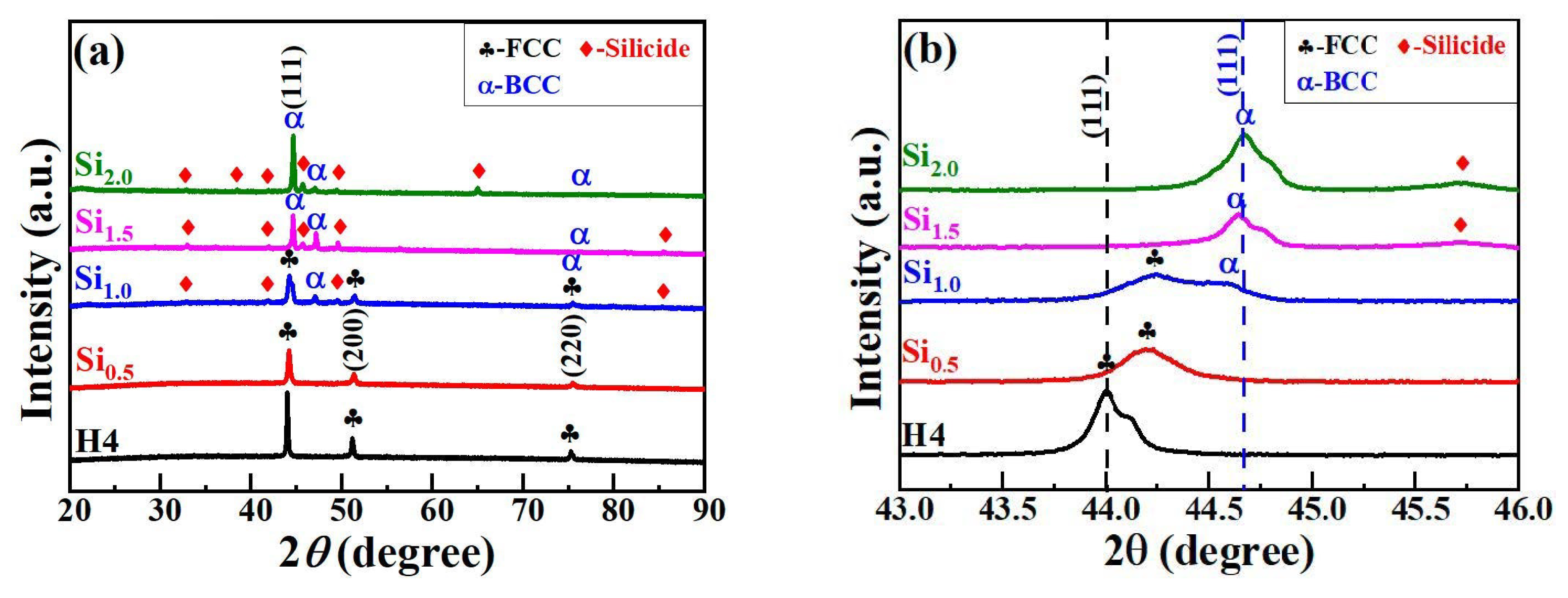
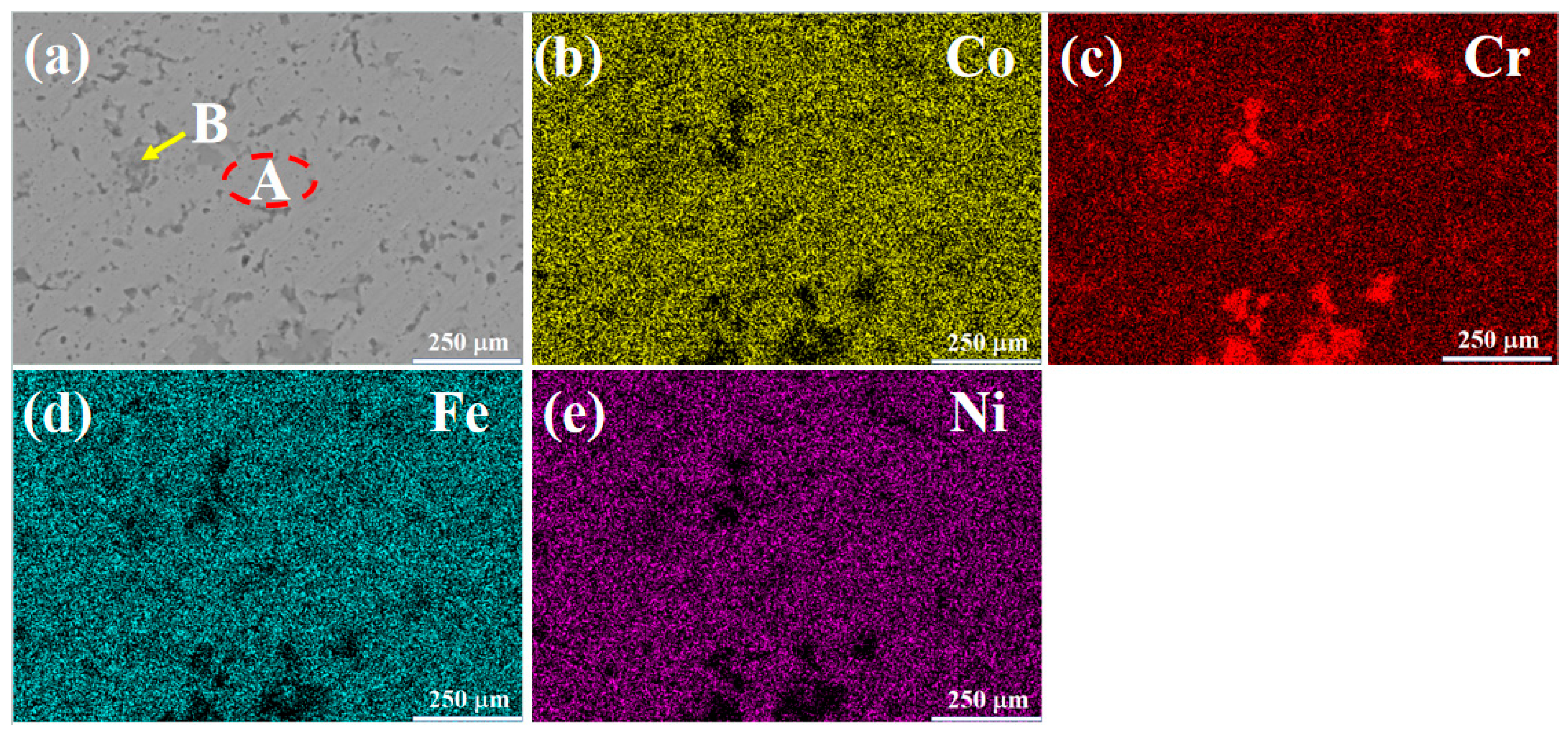
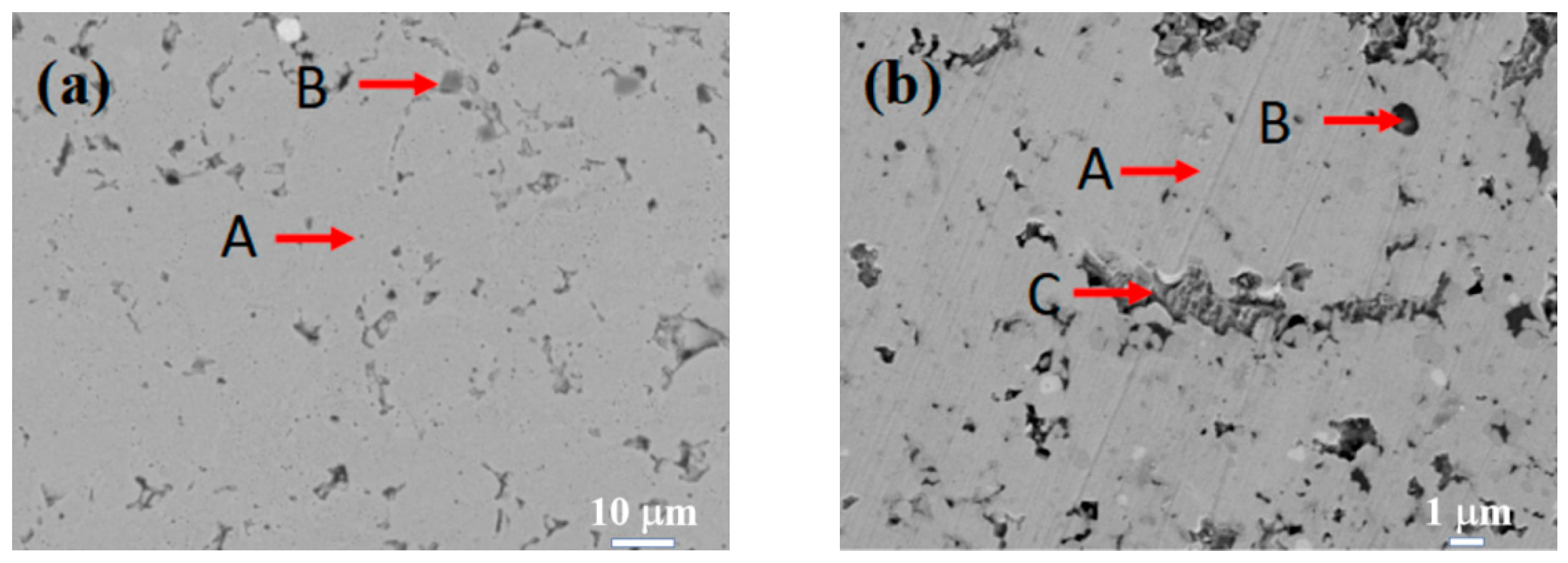
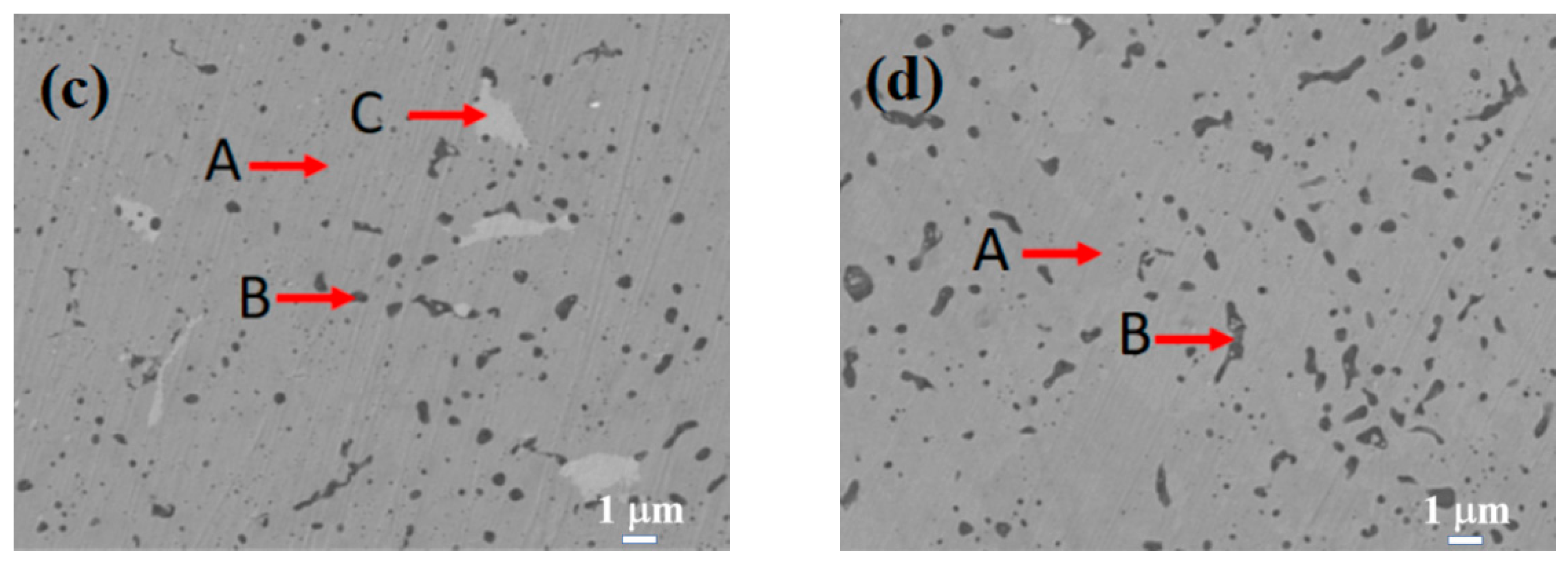
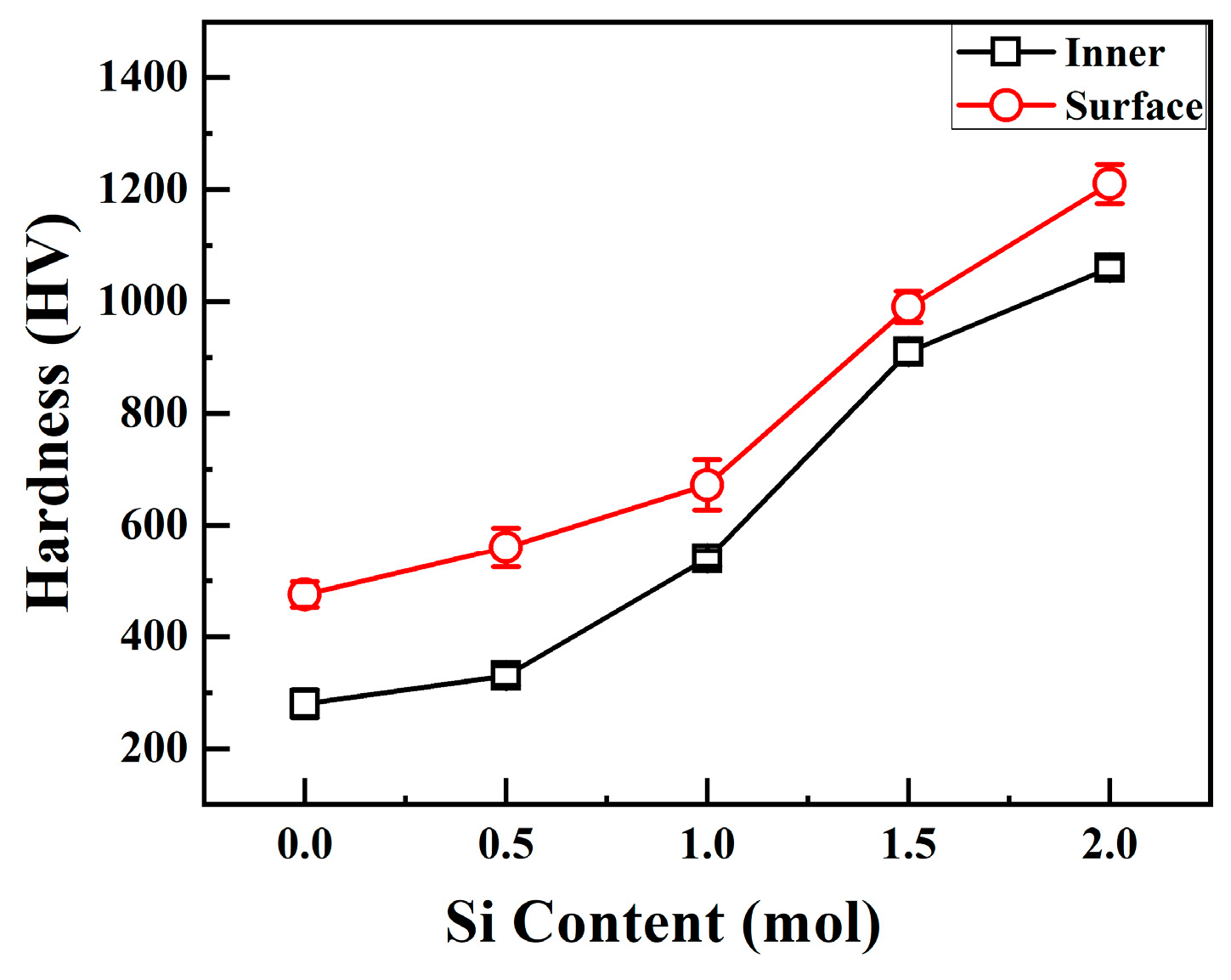
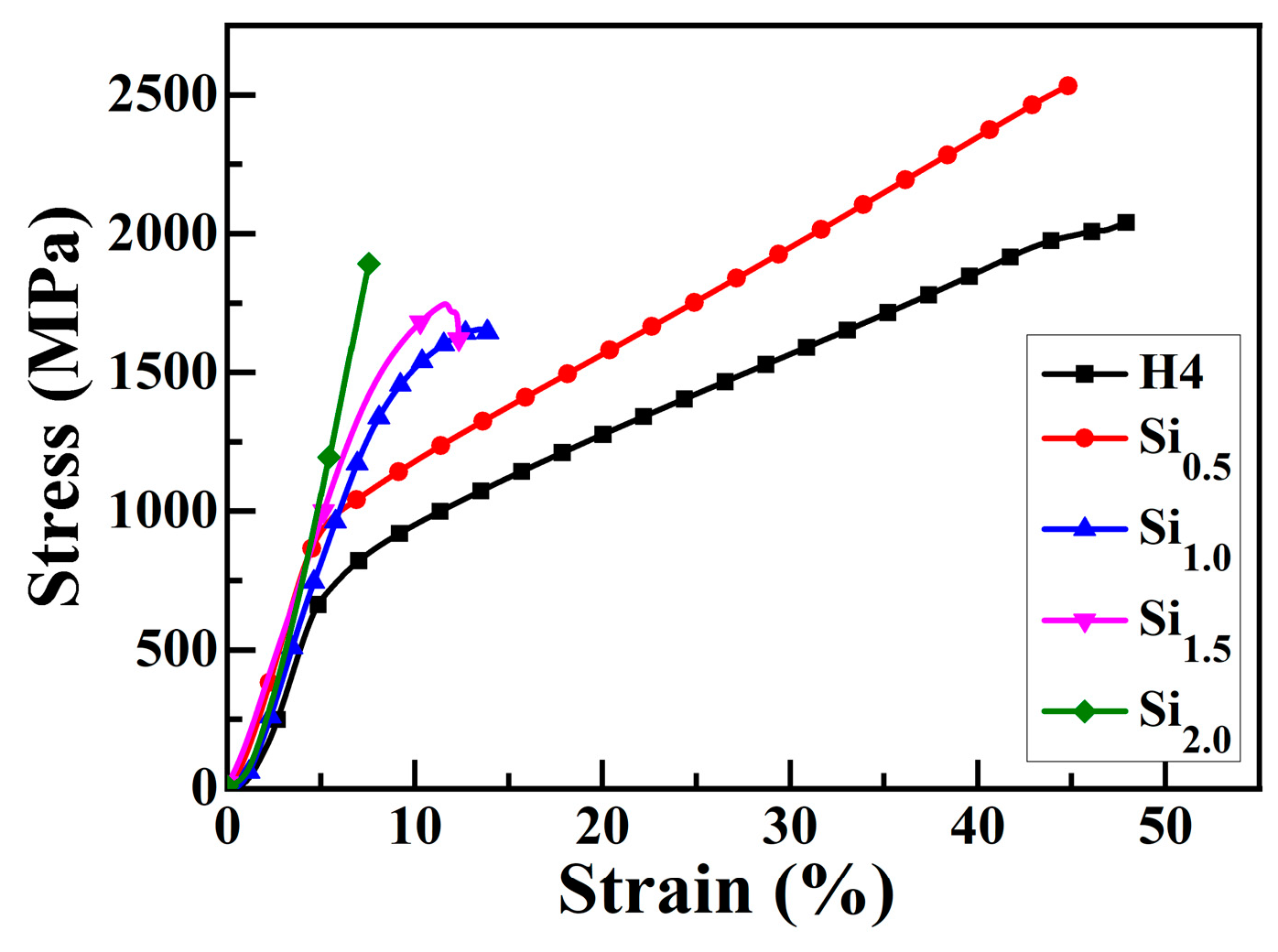
| No. | Alloy | Co | Cr | Fe | Ni | Si |
|---|---|---|---|---|---|---|
| H4 | CoCrFeNi | 25.0 | 25.0 | 25.0 | 25.0 | 0 |
| Si0.5 | CoCrCuFeMnSi0.5 | 22.2 | 22.2 | 22.2 | 22.2 | 11.2 |
| Si1.0 | CoCrCuFeMnSi1.0 | 20.0 | 20.0 | 20.0 | 20.0 | 20.0 |
| Si1.5 | CoCrCuFeMnSi1.5 | 18.2 | 18.2 | 18.2 | 18.2 | 27.2 |
| Si2.0 | CoCrCuFeMnSi2.0 | 16.7 | 16.7 | 16.7 | 16.7 | 33.2 |
| Alloy | ρt (g·cm−3) | ρm (g·cm−3) | D (%) |
|---|---|---|---|
| H4 | 8.05 | 7.73 | 96.0 |
| Si0.5 | 7.48 | 7.23 | 96.7 |
| Si1.0 | 6.87 | 6.67 | 97.1 |
| Si1.5 | 6.45 | 6.30 | 97.7 |
| Si2.0 | 6.11 | 6.01 | 98.4 |
| Element | Co | Cr | Fe | Ni | Si |
|---|---|---|---|---|---|
| Co | 0 | −4 | −1 | 0 | −38 |
| Cr | −4 | 0 | −1 | −7 | −37 |
| Fe | 0 | −1 | 0 | −2 | −35 |
| Ni | 0 | −7 | −2 | 0 | −40 |
| Si | −38 | −37 | −35 | −40 | 0 |
| Alloy | ΔHmix (KJ/mol) | ΔSmix | Tm (K) | Ω | δ (%) | VEC |
|---|---|---|---|---|---|---|
| H4 | −3.75 | 11.53 | 1858.8 | 5.72 | 0.3 | 8.25 |
| Si0.5 | −17.78 | 13.15 | 1839.2 | 1.36 | 3.76 | 7.78 |
| Si1.0 | −26.40 | 13.38 | 1823.6 | 0.92 | 4.83 | 7.4 |
| Si1.5 | −31.74 | 13.25 | 1839.2 | 0.77 | 5.42 | 7.09 |
| Si2.0 | −35.00 | 12.98 | 1800.2 | 0.67 | 5.78 | 6.83 |
| Alloy | Region | Co | Cr | Fe | Ni |
|---|---|---|---|---|---|
| H4 | A | 27.9 | 16.1 | 29.2 | 26.8 |
| B | 7.7 | 77.9 | 5.9 | 8.5 |
| Alloy | Region | Co | Cr | Fe | Ni | Si |
|---|---|---|---|---|---|---|
| Si0.5 | A | 25.6 | 20.1 | 22.7 | 17.9 | 13.7 |
| B | 14.3 | 31.8 | 25.8 | 13.2 | 14.9 | |
| Si1.0 | A | 23.4 | 19.3 | 21.2 | 19 | 17.1 |
| B | 14.2 | 14.1 | 12.4 | 30.5 | 28.8 | |
| C | 8.3 | 28.9 | 31.2 | 10.1 | 21.5 | |
| Si1.5 | A | 12.7 | 21.3 | 29.3 | 17.1 | 19.6 |
| B | 11.5 | 10.4 | 15.6 | 20.1 | 42.4 | |
| C | 8.2 | 51.9 | 10.4 | 11.3 | 18.2 | |
| Si2.0 | A | 18.4 | 18.8 | 20.3 | 18.8 | 23.7 |
| B | 7.4 | 8.5 | 9.1 | 32.2 | 42.8 |
| Alloy | σ0.2 (MPa) | σb (MPa) | εf (%) | Hardness (HV) |
|---|---|---|---|---|
| H4 | 760 ± 38 | -- | -- | 280 ± 25 |
| Si0.5 | 910 ± 52 | -- | -- | 330 ± 18 |
| Si1.0 | 1570 ± 84 | 1630 ± 75 | 17 ± 0.9 | 540 ± 14 |
| Si1.5 | 1640 ± 88 | 1710 ± 98 | 13 ± 0.6 | 910 ± 20 |
| Si2.0 | -- | 1880 ± 94 | 6 ± 0.2 | 1060 ± 17 |
Disclaimer/Publisher’s Note: The statements, opinions and data contained in all publications are solely those of the individual author(s) and contributor(s) and not of MDPI and/or the editor(s). MDPI and/or the editor(s) disclaim responsibility for any injury to people or property resulting from any ideas, methods, instructions or products referred to in the content. |
© 2025 by the authors. Licensee MDPI, Basel, Switzerland. This article is an open access article distributed under the terms and conditions of the Creative Commons Attribution (CC BY) license (https://creativecommons.org/licenses/by/4.0/).
Share and Cite
Zhou, Y.; Zhao, R.; Ren, B.; Jiang, A.; Liu, Z.; Liu, J. Influence of Si Content on Microstructure and Mechanical Properties of CoCrFeNi High-Entropy Alloys. Metals 2025, 15, 538. https://doi.org/10.3390/met15050538
Zhou Y, Zhao R, Ren B, Jiang A, Liu Z, Liu J. Influence of Si Content on Microstructure and Mechanical Properties of CoCrFeNi High-Entropy Alloys. Metals. 2025; 15(5):538. https://doi.org/10.3390/met15050538
Chicago/Turabian StyleZhou, Yajun, Ruifeng Zhao, Bo Ren, Aiyun Jiang, Zhongxia Liu, and Jianxiu Liu. 2025. "Influence of Si Content on Microstructure and Mechanical Properties of CoCrFeNi High-Entropy Alloys" Metals 15, no. 5: 538. https://doi.org/10.3390/met15050538
APA StyleZhou, Y., Zhao, R., Ren, B., Jiang, A., Liu, Z., & Liu, J. (2025). Influence of Si Content on Microstructure and Mechanical Properties of CoCrFeNi High-Entropy Alloys. Metals, 15(5), 538. https://doi.org/10.3390/met15050538







